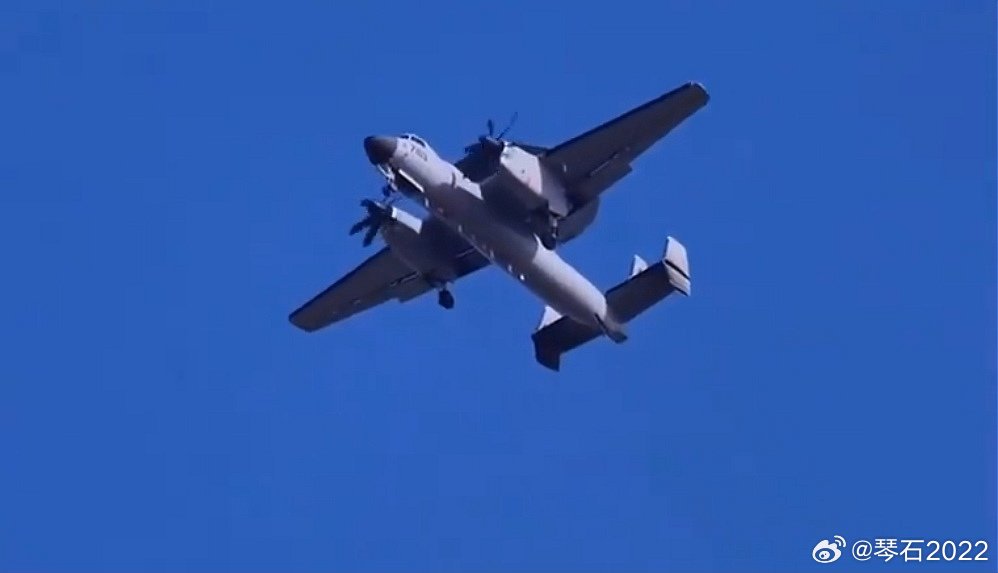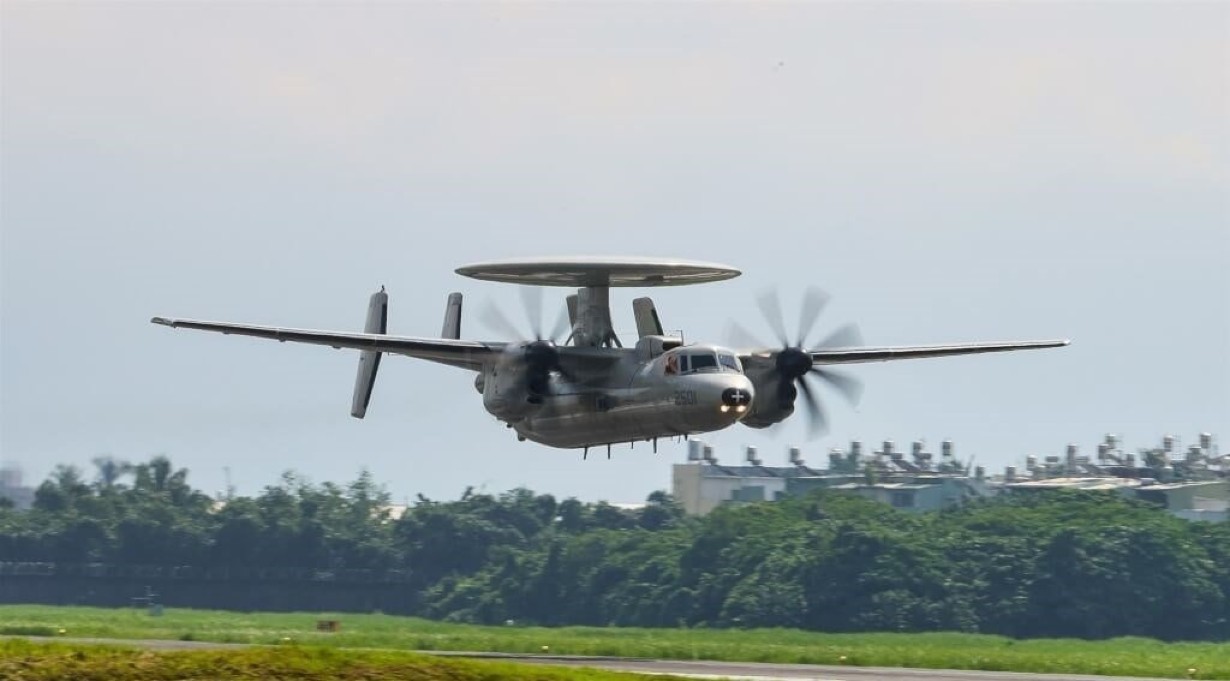China’s futuristic ‘eye in the sky’ aircraft, the KJ-600 airborne early warning and control (AEW&C), was recently photographed at an unknown location, indicating that flight testing is going on in full earnest.
1:1 BATTLE: J-20 vs Rafale: Why Indian Fighters Would Outclass Chinese “Stealth” Jets In A Real War
Pictures circulated on Chinese social media platforms seemed to show the Xian KJ-600 conducting test flights. Interestingly, the plane was painted in a gray color scheme. Military bloggers subsequently posted the photos on Platform X (previously Twitter).
While the precise time and location of the photographs remain unknown, we know that the Xian Aircraft Industrial Corporation has been developing the aircraft in the city of Xian in the country’s central Shaanxi province.
A video of the aircraft in flight believed to be the first of this futuristic aircraft, was also shared on social media. The aircraft in the video is reportedly one of the six prototypes and goes by the number ‘7103’.
Some military watchers, citing satellite images accessed by them, said that besides the flight tests, the ground catapulting tests have also been conducted with the KJ-600.
According to experts, the grey paint scheme may have been used to minimize the aircraft’s visibility. The images highlight the aircraft’s arresting hook, which is located in a V-shaped recess in the rear fuselage.
The recently released pictures show the aircraft with a tricycle landing gear, a four-fin tail, and a straight high-wing configuration: features that highlight China’s aspirations to improve its aerial command and maritime surveillance capabilities.

Additionally, reports from late 2023 suggested that the KJ-600 development program was in an advanced phase and could be close to low-rate production.
Chinese state media posits that China’s strategic position in the seas will be buttressed with the anticipated integration of the KJ-600 into People’s Liberation Army Navy (PLAN) operations, allowing it to improve its aerial command and maritime surveillance capabilities.
Chinese experts predicted that the carrier-based early warning aircraft will soon make an official appearance after the PLA Navy’s carrier-based J-15 fighters conducted a training exercise last month with early warning aircraft — albeit with a variant currently based only on land but not on aircraft carriers.
L'un des prototypes de l'AEW embarqué chinois KJ-600, immatriculé 7103, a été filmé lors d'un vol d'essais.
Les images satellites montrent que les tests de catapultage au sol ont également été entrepris. pic.twitter.com/w8FC63Qwrd
— East Pendulum (@HenriKenhmann) March 23, 2024
Early warning aircraft are crucial power amplifiers that can gather a lot of data, evaluate it, and provide missions to other combat units. They can also detect, track, monitor, and direct attacks against targets.
The three early warning aircraft types now operated by PLA are the KJ-2000, which has a turbofan engine, the KJ-200 and KJ-500, which have turboprop engines, and the KJ-500. These aircraft are intended to operate from airfields rather than aircraft carriers.
Chinese analysts underscored that carriers require their early warning systems when operating at great distances from land since the land-based early warning aircraft can only help carrier-based fighters when operating close to the land and not when sailing in the far seas.
With tensions raging in the Indo-Pacific and any potential conflict involving China predicted to take place over the seas, a carrier-based AEW&C aircraft could be the key to conducting operations against the adversary. Experts pointed out that coordination between carrier-based fighter jets and early warning aircraft will speed up upgrading combat capabilities.
What Do We Know About KJ-600?
Like other well-known Chinese aircraft programs, the KJ-600 is little known, save from infrequent sightings reported on China’s severely restricted Internet.
The KJ-600 first flew in mid-2020. It sports a quad-fin tailplane, tricycle gear, and a large dorsal rotodome suspected to be fitted with an AESA-type system.
The KJ-600 is believed to have a wingspan of 24.4 meters and a length of 18.4 meters based on measurements from satellite photography, which is consistent with the small size predicted for an aircraft deployed on a carrier. It is, however, noteworthy that the aircraft looks longer than that as sighted on its recent flight, according to military watchers.
Based on satellite imagery, experts predicted that the six-bladed turboprop engines are most likely that of the WJ-6C. A small tailhook tip and a rear Y-shaped depression in the fuselage essentially prove the presence of a Y-shaped tailhook for arrested recovery, and a catapult launch bar on the nose landing gear verifies CATOBAR launch compatibility.

Additionally, there are several antennas on the ventral fuselage, below the wings, and a box-shaped antenna in the back of the aircraft. It’s possible to see the wing fold lines.
The Type 001 Liaoning and Type 002 Shandong carriers that China currently operates are not expected to be the KJ-600’s primary carriers as they are outfitted with ski-jump ramps.
Although the PLAN’s active fleet of Shenyang J-15 fighter jets may handle this launch idea at lower gross weights, the turboprop-powered KJ-600 will probably need a catapult, of which Type 003 possesses three.
KJ-600 is anticipated to participate in the air wing that the PLAN seems to be preparing for its newest aircraft carrier, the Fujian. Its primary mission will be to significantly increase the carrier’s radar range, particularly in identifying objects flying at low altitudes or even making surface contacts.
This is in addition to managing battlespaces. For highly coordinated operations, controllers on board will act as battlespace awareness, central command and control, and aircraft vectoring as needed. The carrier group and other tactical aircraft can access the radar picture and data from the KJ-600 and other passive sensor systems in real time.
The E-2 series, created by the US corporation Northrop Grumman, is the only fixed-wing carrier-based AEWC currently used worldwide. This is why China’s development of the KJ-600 by Xi’an Aircraft Industrial Corporation as an aircraft carrier-launched Airborne Early Warning and Control system (AEW&C) is seen as a “copycat” move.
American weapons developers and the Pentagon have been troubled by the PLA’s attempts to “replicate” or “hijack” US platforms and technologies. The Chinese military has also been modeling tactics, methods, and doctrinal approaches to integrate, adapt, and deploy modern technologies in the most effective ways in recent years.

Moreover, the defense electronics company CETC displayed a promotional video at the 2018 Airshow China in Zhuhai showing a twin-turboprop aircraft, possibly the KJ-600, using its KLC-7 AESA radar to conduct an engagement against a group of adversary fighters that looked like Boeing F/A-18E/F Super Hornets.
The US experts feel the PLA has been maturing surveillance planes like the KJ-600 and is replicating the successful features of the E-2D Hawkeye, the American all-weather, carrier-capable tactical AEW aircraft. The E-2 Hawkeye has the longest production run of any carrier-based aircraft, continuously producing variants since 1960.
The KJ-600 is seemingly in advanced stages of testing and may soon be inducted into service to pose a stiff challenge to the US Navy, along with its other regional adversaries.
- Contact the author at sakshi.tiwari9555 (at) gmail.com
- Follow EurAsian Times on Google News




